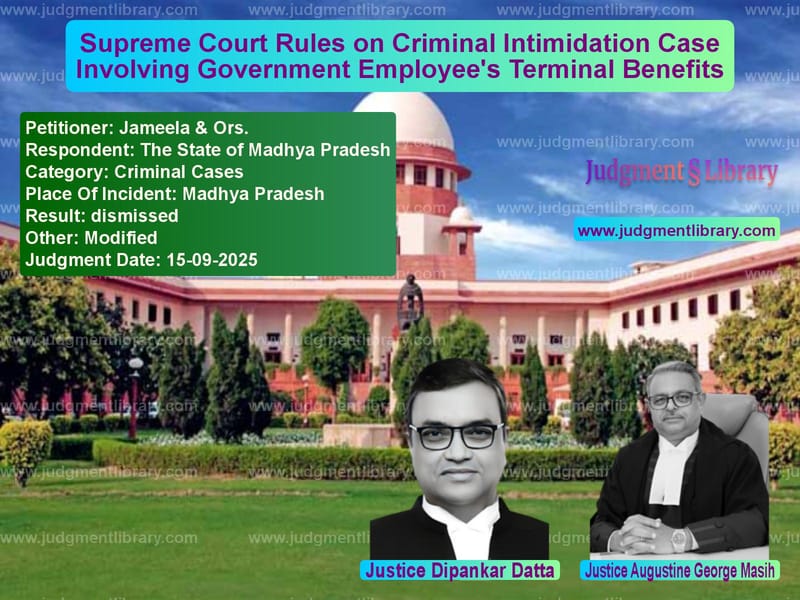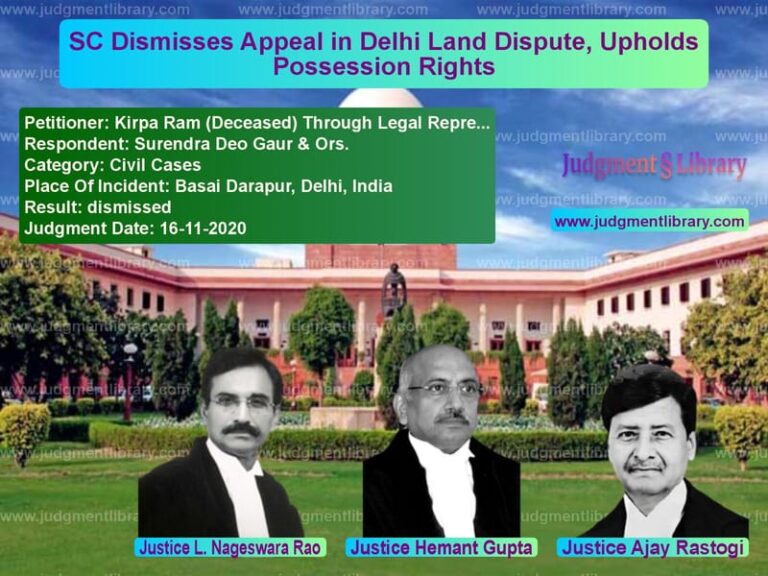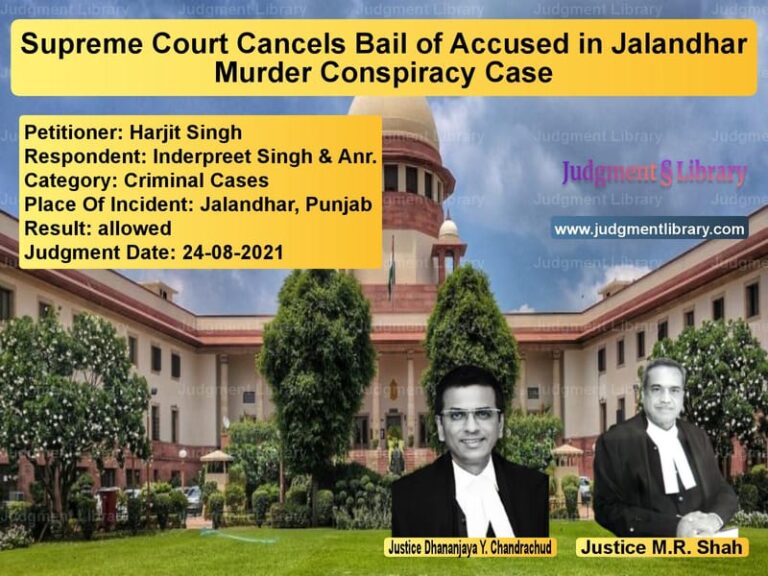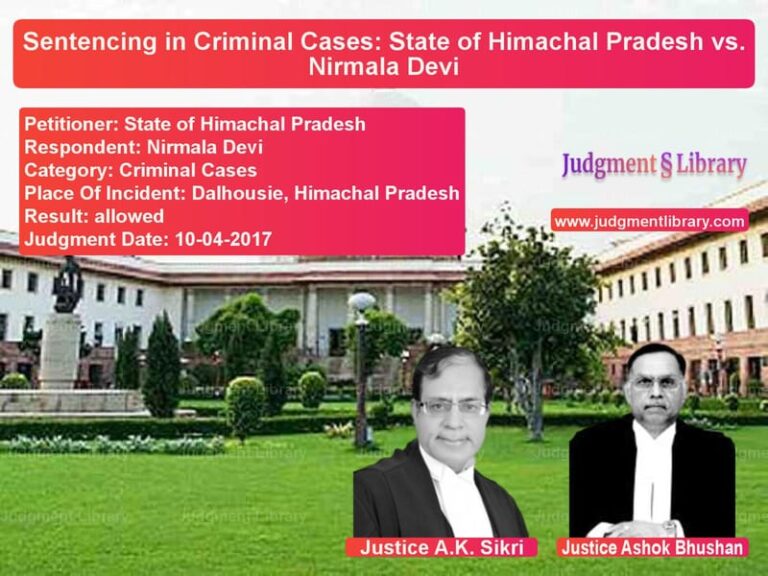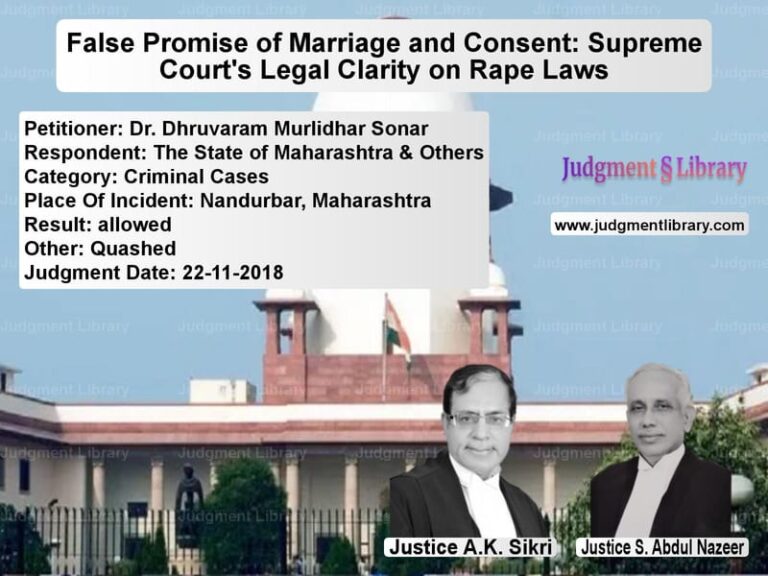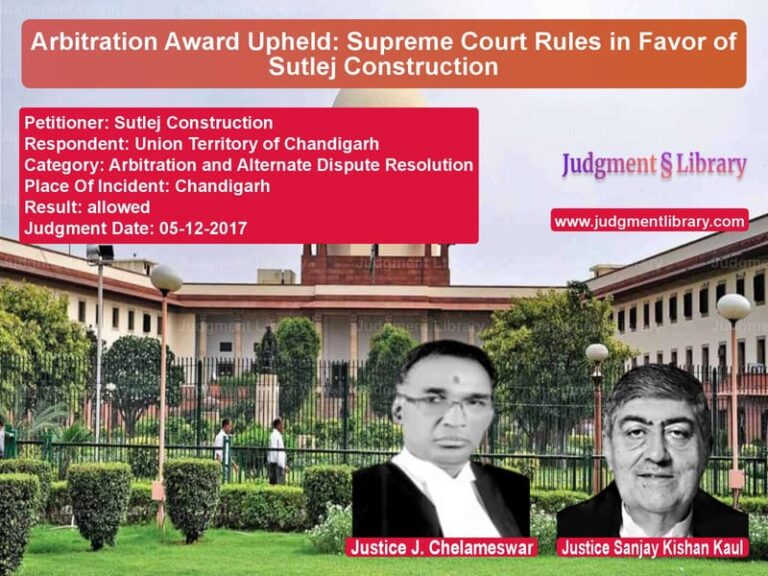Supreme Court Rules on Criminal Intimidation Case Involving Government Employee’s Terminal Benefits
A complex legal saga spanning over two decades reached its conclusion in the Supreme Court of India, presenting a poignant intersection of criminal law, procedural justice, and humanitarian considerations. The case centered around Sheikh Akhtar, a former court official convicted for his involvement in events that led to the tragic suicide of a minor girl. After Akhtar’s untimely death during the appeal process, his family continued the legal battle, hoping to clear his name and secure the terminal benefits he had earned through three decades of government service. What unfolded was a intricate legal journey through multiple courts, examining evidence from long-past events and applying legal principles to determine final justice in a case that balanced strict legal interpretation with compassionate consideration for surviving family members.
The Tragic Beginning
The case originated from heartbreaking events that unfolded on February 19, 1999, when a minor girl, who was a witness in a molestation case against co-accused Munna, set herself on fire after allegedly facing repeated threats. According to the prosecution’s case, Akhtar, along with Munna, Bhadde, and Mamu Gudda, had threatened the victim with dire consequences if she testified against Munna in court. The threats allegedly included warnings that both she and her father would be killed unless she compromised the matter. Unable to bear the pressure and wanting to save her father, the victim took the extreme step of self-immolation. She suffered severe burns and succumbed to her injuries four days later on February 23, 1999, setting in motion a legal process that would continue for more than two decades.
The Initial Legal Proceedings
The victim’s mother filed a First Information Report detailing the threats that preceded her daughter’s tragic decision. During the trial, several witnesses provided crucial testimony. PW-2, the local Deputy Tehsildar, had recorded the victim’s dying declaration, though this document was unfortunately not available during the Supreme Court proceedings. PW-3, the victim’s elder sister, testified that while attempts were being made to douse the flames, the victim had revealed that Akhtar and the others had threatened her both while going to court and while returning, directly leading to her desperate act. PW-4, the victim’s mother, provided detailed testimony about encountering Akhtar and the co-accused around 11 am while accompanying her daughter to court and later learning about a second round of threats that occurred when she briefly left her daughter alone at the court premises.
The Trial Court’s Decision and Consequences
The Sessions Court, after considering all evidence, convicted Akhtar under sections 305 (abetment to suicide of child) and 506-B (criminal intimidation) of the Indian Penal Code on March 28, 2007. The court sentenced him to rigorous imprisonment for ten years for the abetment charge and two years for criminal intimidation, along with financial penalties. This conviction had immediate professional consequences for Akhtar, who served as a ‘Naib Nazir’ in the local court. He faced termination from his position as a public servant, losing not only his current employment but also putting at risk the terminal benefits he had accumulated during his more than 30 years of government service.
The Appeal Process and an Unexpected Turn
Akhtar appealed his conviction before the High Court of Madhya Pradesh in 2007, beginning what would become a prolonged legal process. However, in an unexpected development, Akhtar passed away on April 23, 2015, while his appeal was still pending. Under normal circumstances, section 394 of the Code of Criminal Procedure would cause an appeal to abate upon the death of the accused. However, Akhtar’s widow, Jameela, and their children made the unusual decision to continue the appeal, motivated by the hope that if the conviction were set aside, they would become entitled to the terminal benefits Akhtar had accrued during his long government service. This decision transformed the case from solely about criminal liability to also involving property and service rights of surviving family members.
The High Court’s Modified Judgment
The High Court delivered its significant judgment on April 25, 2024, making important modifications to the trial court’s decision. The court held that “Akhtar cannot be held guilty for commission of offence under section 305 IPC; however, by reason of his acts of threatening the victim (a minor girl), Akhtar was guilty of the offence under section 195-A IPC.” This section deals with threatening or inducing any person to give false evidence. Accordingly, while setting aside the conviction under section 305 IPC, the High Court convicted Akhtar under section 195-A IPC as well as section 506-B thereof and maintained the sentence imposed by the Sessions Court. This decision represented a partial victory for Akhtar’s family, as the more serious abetment to suicide charge was dropped, but maintained his criminal liability for intimidation-related offenses.
Read also: https://judgmentlibrary.com/supreme-court-upholds-liberty-principles-in-anticipatory-bail-case/
Arguments Presented to the Supreme Court
Dissatisfied with the High Court’s decision, Akhtar’s family approached the Supreme Court, where their counsel raised several crucial arguments. He pointed to evidentiary inconsistencies, stating that “there is gross inconsistency in the version of PW-4, as recorded in the FIR, the victim’s dying declaration recorded by PW-2 and the depositions of PWs 3 and 4 as regards the number of times the victim was threatened on 19th February, 1999.” Specifically, he noted that PW-4 did not refer to the second act of threatening in the FIR, creating doubt about the sequence of events.
The appellants’ counsel also highlighted witness discrepancies, arguing that “although the victim, PW-3 and PW-4 had spoken about Akhtar and the other co-convicts having threatened the victim, the versions of the other prosecution witnesses (PWs 5, 6 and 7) is that the victim had taken the names of Munna, Bhadde, and Mamu Gudda but not Akhtar as those who had also threatened her.” This selective naming raised questions about Akhtar’s specific involvement.
Most significantly, the appellants’ counsel presented a substantial legal argument regarding the application of section 195-A IPC, contending that “the High Court grossly erred in convicting Akhtar under section 195-A IPC. The incident which resulted in unfortunate death of the victim, as noticed earlier, occurred on 19th February, 1999. Section 195-A IPC was inserted by Act No.2 of 2006 with effect from 16th April, 2006. As on date of the offence, section 195-A IPC was not on the statute book. The High Court, therefore, fell in error in not noticing the date of offence and the date of insertion of section 195-A in the IPC and proceeded to hold Akhtar guilty under that section in clear breach of clause (1) of Article 20 of the Constitution of India.” This argument invoked the constitutional protection against ex post facto laws, which prohibits convicting someone under laws that didn’t exist when the alleged offense was committed.
The counsel for the respondent-State, while “not making any attempt to justify the High Court’s conviction of Akhtar under section 195-A IPC, pointed out to us that Akhtar was held guilty of the offence under section 506-B IPC and the finding of the trial court, since affirmed by the High Court in this regard, does not suffer from any infirmity.” This position acknowledged the legal error regarding section 195-A while maintaining that the core conviction for criminal intimidation remained valid.
The Supreme Court’s Detailed Analysis
The Supreme Court bench comprising Justice Dipankar Datta and Justice Augustine George Masih conducted a thorough examination of the arguments and evidence. Regarding the inconsistency in witness statements, the Court provided a nuanced perspective: “True it is, PW-4 did not refer to the second act of threatening in the FIR. However, the omission is not considered too material. PW-4, we can presume, must have been under severe emotional stress when information of the offence was given to the police. That apart, it is not the requirement of law that an FIR while disclosing a cognizable offence must also reveal all facts preceding and following the incident of offence with precision. Having considered the contentions and looking at the materials on record, we do not see reason to hold that the inconsistency, as pointed out, is such that the same would lead us to discredit the evidence of PWs 3 and 4 that Akhtar, along with the co-convicts, had not threatened the victim.” This reasoning acknowledged the practical realities of witness testimony during traumatic events while maintaining the overall credibility of the prosecution’s case.
On the issue of some witnesses not naming Akhtar specifically, the Court stated: “Having read the evidence of PWs 3 and 4 as well as considering what was recorded by PW-2 as the dying declaration of the victim, we have no hesitation to overrule this contention. Merely because PWs 5, 6 and 7 had not taken the name of Akhtar while referring to what they heard the victim say about the identity of those who had threatened her would in no way render the version of the victim, as recorded by PW-2, unreliable. In fact, narration of the version of the victim in the dying declaration by PW-2 finds support from the evidence of PWs 3 and 4.” This analysis demonstrated the Court’s approach to evaluating conflicting testimony by considering the weight and consistency of core evidence rather than isolated discrepancies.
The Court unequivocally agreed with the appellants regarding the conviction under section 195-A IPC, stating: “We are in agreement with learned counsel for the appellants that the High Court could not have found Akhtar guilty of Section 195-A IPC.” However, the Court immediately noted that “what cannot be ignored is that Akhtar was also found guilty of an offence under section 506(B) IPC,” signaling that while one conviction was legally flawed, the other required separate examination.
Examining the Remaining Conviction
The Court conducted a detailed examination of the High Court’s handling of the section 506-B IPC conviction and discovered a significant procedural issue: “in the entirety of the appellate judgment and order, impugned before us, we do not find any discussion made by the High Court in respect of the conviction recorded against Akhtar under section 506-B IPC.” The Court explained this omission by noting that “since the High Court had embarked on a process of reasoning to convict Akhtar under section 195-A IPC, it did not consider it necessary to make any further discussion regarding the offence under section 506-B IPC.”
With the conviction under section 195-A IPC being set aside due to the ex post facto application, the Supreme Court found it necessary to independently examine whether the offense under section 506-B IPC stood proved. After thorough examination of the record, the Court concluded: “Considering the evidence on record and in view of our discussions as above relatable to the evidence of PWs 2, 3 and 4, we have no hesitation in holding that Akhtar was one of four who threatened the victim and, therefore, his conviction under section 506-B warrants no interference.” This independent assessment ensured that despite the High Court’s procedural lapse, the substantive justice was properly evaluated.
The Court also addressed the defense evidence presented by DWs 3 and 4, who testified that Akhtar was present in court throughout the day on February 19, 1999, potentially creating an alibi. The Court noted that the Sessions Court had already considered this evidence and assigned “good reasons as to why the defence evidence did not appeal to him to be creditworthy for discrediting the versions of PWs 2, 3 and 4.” The Supreme Court found no reason to interfere with this assessment, demonstrating appropriate deference to the trial court’s factual findings.
Final Judgment and Humanitarian Direction
The Supreme Court ultimately held: “In our view, conviction of Akhtar under section 506-B IPC cannot be interfered with on any valid ground, although his conviction under section 195-A IPC by the High Court is unsustainable in law.” The Court dismissed the appeal while setting aside the conviction under section 195-A IPC but maintaining the conviction under section 506-B IPC.
However, recognizing the unique circumstances and humanitarian aspects of the case, the Court made an important observation regarding Akhtar’s terminal benefits. The Court noted: “Akhtar’s service was terminated on consideration of his conviction not only for the offence under section 506-B IPC but also the graver offence under section 305 thereof. Since the High Court has set aside the conviction under section 305 IPC and the alternative conviction under section 195-A thereof too stands set aside by us, only the conviction against Akhtar for the offence under section 506-B IPC survives.”
In a significant humanitarian gesture, the Court concluded: “In such circumstances, we are of the considered opinion that interests of justice would be best served if the respondent-State considers the matter of termination of service of Akhtar de novo and decides, whether for his conviction only under section 506-B IPC, the right to terminal benefits accruing for rendering three decades of service would stand forfeited for all times to come.”
The Court accordingly requested “the appropriate department in the Government of Madhya Pradesh to effect consideration of the matter as indicated in the preceding paragraph upon taking into account the financial status of the appellant no.1 and her liability, if any, adopting a humanitarian approach.” The Court directed that this consideration be completed within three months, providing a practical timeline for resolution while acknowledging the family’s pressing financial needs.
Broader Implications and Conclusion
This judgment represents the complex interplay between strict legal principles and humanitarian considerations in the Indian judicial system. While the Supreme Court upheld the criminal conviction based on evidence establishing Akhtar’s participation in threatening a minor witness, it also recognized the need for compassion toward his surviving family. The case demonstrates how courts must balance the requirements of justice with empathy, particularly when dealing with cases that extend over decades and involve families who weren’t directly involved in the original offenses.
The directive to the state government to reconsider the terminal benefits issue acknowledges that while criminal conduct must have consequences, the punishment should be proportionate, and innocent family members should not suffer unduly for actions they didn’t commit. This approach reflects the evolving jurisprudence that recognizes the collateral consequences of legal decisions on families and dependents. The judgment also serves as an important reminder about the proper application of criminal laws, particularly regarding the prohibition against ex post facto application, which forms a fundamental protection in criminal jurisprudence worldwide.
Ultimately, this case illustrates how the Indian judiciary navigates complex legal questions while maintaining compassion for those affected by its decisions, balancing the scales of justice with the scales of humanity in a manner that strengthens public confidence in the legal system.
Petitioner Name: Jameela & Ors..Respondent Name: The State of Madhya Pradesh.Judgment By: Justice Dipankar Datta, Justice Augustine George Masih.Place Of Incident: Madhya Pradesh.Judgment Date: 15-09-2025.Result: dismissed.
Don’t miss out on the full details! Download the complete judgment in PDF format below and gain valuable insights instantly!
Download Judgment: jameela-&-ors.-vs-the-state-of-madhya-supreme-court-of-india-judgment-dated-15-09-2025.pdf
Directly Download Judgment: Directly download this Judgment
See all petitions in Suicide Cases
See all petitions in Extortion and Blackmail
See all petitions in Termination Cases
See all petitions in Pension and Gratuity
See all petitions in Judgment by Dipankar Datta
See all petitions in Judgment by Augustine George Masih
See all petitions in dismissed
See all petitions in Modified
See all petitions in supreme court of India judgments September 2025
See all petitions in 2025 judgments
See all posts in Criminal Cases Category
See all allowed petitions in Criminal Cases Category
See all Dismissed petitions in Criminal Cases Category
See all partially allowed petitions in Criminal Cases Category

